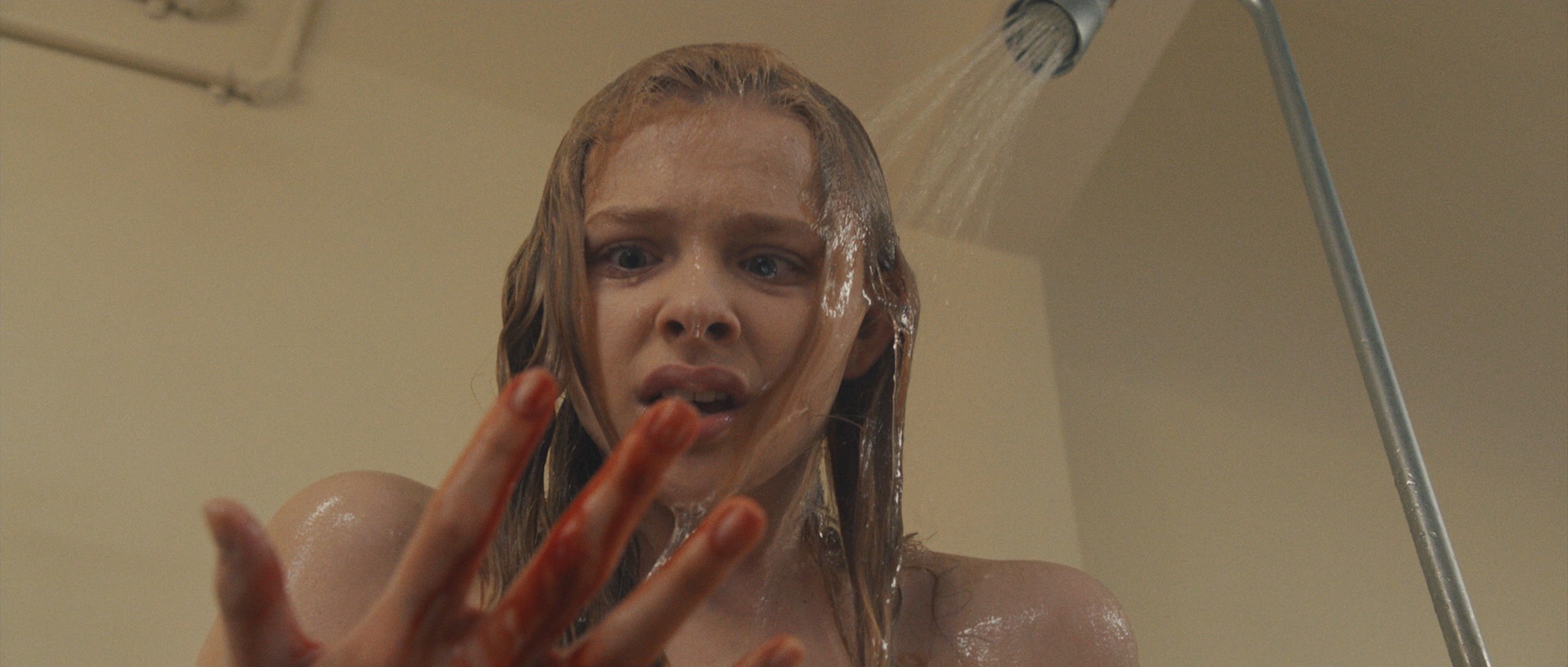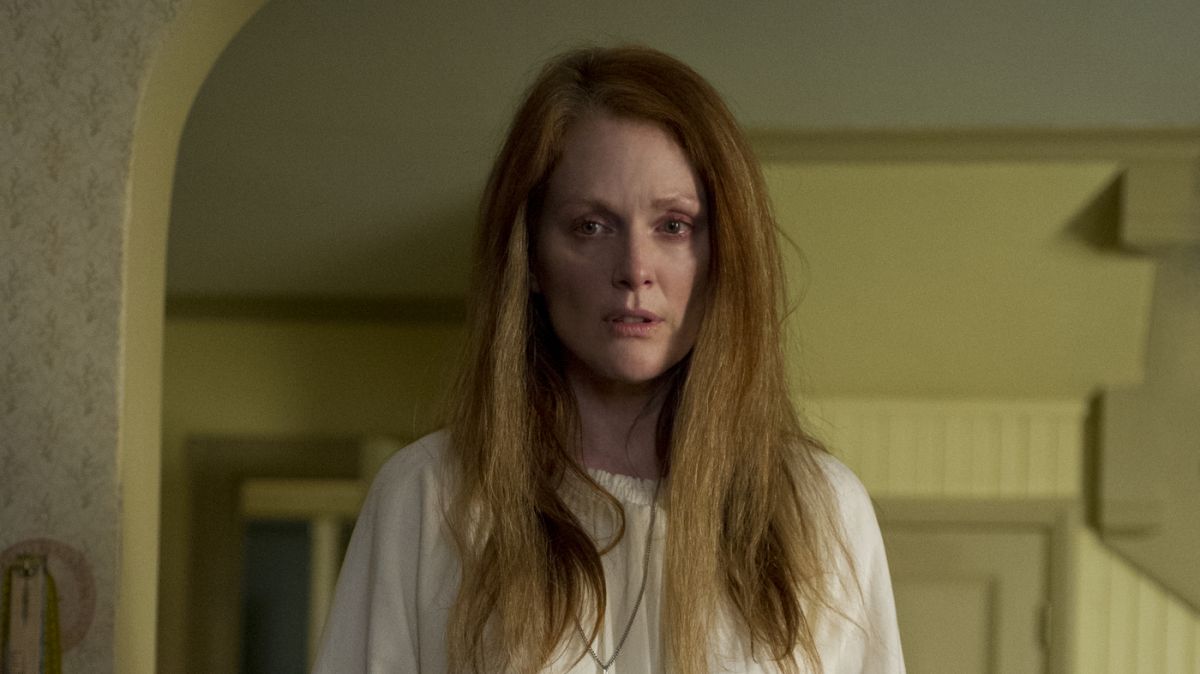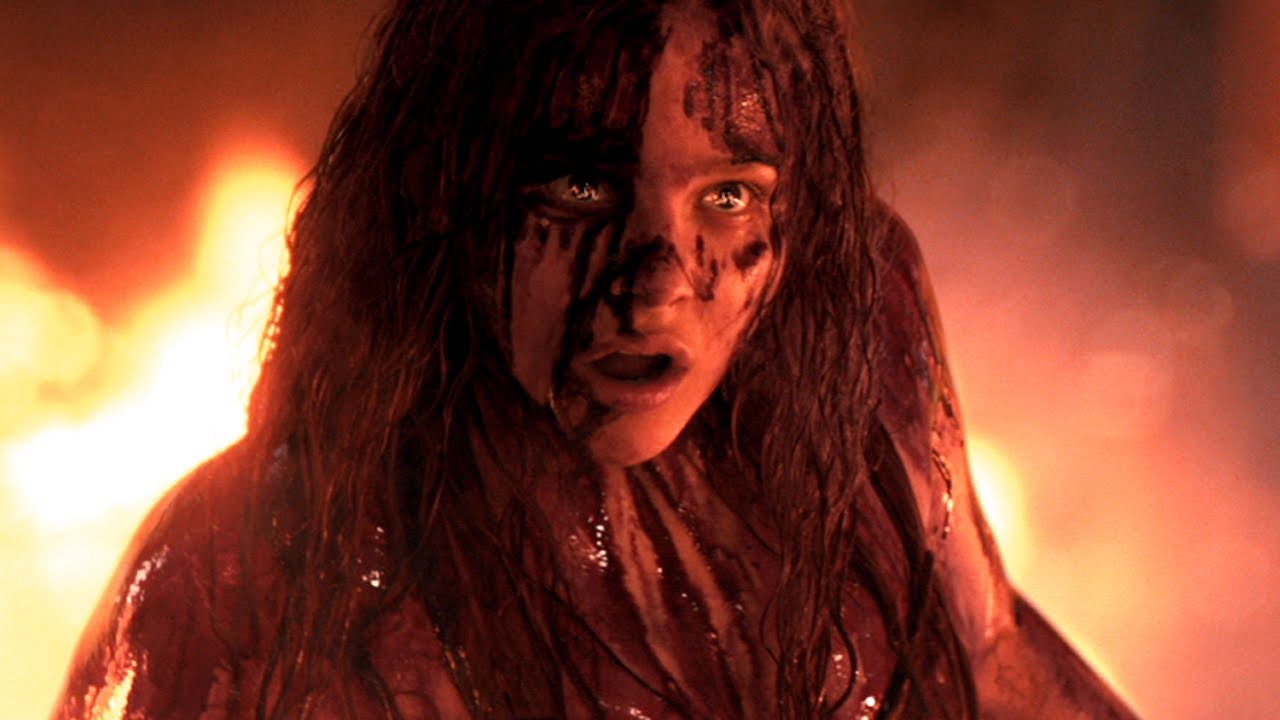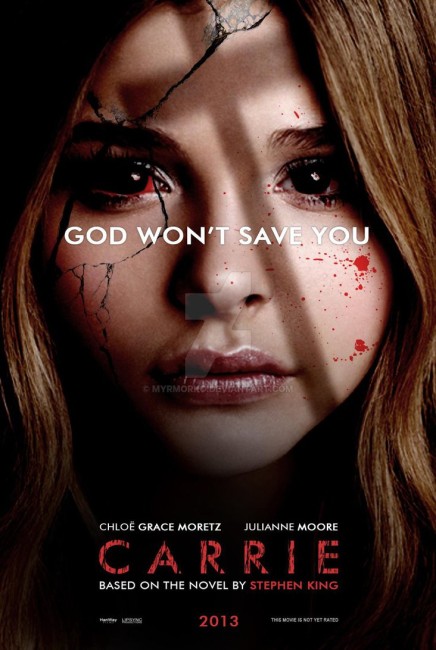USA. 2013.
Crew
Director – Kimberly Peirce, Screenplay – Robert Aguirre-Sacasa & Lawrence D. Cohen, Based on the Novel by Stephen King, Producer – Kevin Misher, Photography – Steve Yedlin, Music – Marco Beltrami, Visual Effects Supervisor – Dennis Berardi, Visual Effects – Mr. X Inc., Additional Visual Effects – Custom Visual Effects & Nhance (Supervisor – Matt Kasmir), Special Effects Supervisor – Warren Appleby, Prosthetic Supervisor – Sean Samson, Production Design – Carol Spier. Production Company – Misher Films.
Cast
Chloë Grace Moretz (Carrie White), Julianne Moore (Margaret White), Gabriella Wilde (Sue Snell), Portia Doubleday (Chris Hargensen), Judy Greer (Ms Desjardin), Ansel Elgort (Tommy Ross), Alex Russell (Billy Nolan), Barry Shabaka Henley (Principal Morton), Cynthia Preston (Eleanor Snell)
Plot
Carrie White has been raised by a religiously obsessed mother and is regarded as the school wallflower. In the school showers, she starts to have her first menstrual period and is so innocent she thinks that she is bleeding to death. The other girls taunt and cruelly pelt her with sanitary napkins until gym teacher Ms Desjardins intervenes. She reprimands those responsible but when the ringleader Chris Hargensen stands up, Ms Desjardins suspends her right to go to the prom. Sue Snell feels guilt about her involvement and decides to make up for it by getting her boyfriend Tommy Ross to ask Carrie to the prom. Carrie defies her mother to accept. Chris however plans a cruel revenge by rigging the election to have Tommy and Carrie elected the prom king and queen and then dumping a bucket of pig’s blood down over Carrie. However, none of them have reckoned with Carrie’s psychic powers, which now explode, turning the prom into a massacre.
Carrie (1974) was the very first novel that Stephen King ever wrote. It could be reasonably argued that King’s ascendancy to the world’s top horror writer began with the film version made of the book, Carrie (1976), which became a success that he and his publishers more than ably capitalised on. The film version was made by Brian De Palma at the absolute peak of his directorial game and featured an astonishing cast with Sissy Spacek and Piper Laurie both receiving Academy Award nominations as respectively Carrie and her mother, and top supporting performances from Nancy Allen, Amy Irving and a young unknown John Travolta. All of the aforementioned received major career boosts, if not in the case of Spacek and Laurie, gave performances that defined their careers, while the success of the film was sufficient to push Brian De Palma to the forefront as a director for a number of years.
Carrie has been variously sequelised and remade prior to this new version. There was the terrible The Rage: Carrie 2 (1999) with Emily Bergl supposedly as Carrie’s half-sister going through exactly the same. There was Carrie (2002), a tv mini-series remake, which was only marginally better, with Angela Bettis as Carrie and Patricia Clarkson as the mother. Carrie was also adapted into a Broadway musical in 1988, although this proved to be a flop that was booed off-stage and closed after only five performances, ending with a $7 million loss that made it one of the most expensive stage flops in history (although it has been revived in more recent years).
Here Carrie is now one of a host of 1970s/80s horror films that have been strip-mined and resurrected in the last ten years, offered up as almost always inferior remakes. See also the likes of The Texas Chainsaw Massacre (2003), Toolbox Murders (2003), Willard (2003), Dawn of the Dead (2004), The Amityville Horror (2005), Assault on Precinct 13 (2005), The Fog (2005), Black Christmas (2006), The Hills Have Eyes (2006), The Omen (2006), Sisters (2006), When a Stranger Calls (2006), The Wicker Man (2006), Halloween (2007), The Hitcher (2007), April Fool’s Day (2008), Day of the Dead (2008), It’s Alive (2008), Long Weekend (2008), Prom Night (2008), Friday the 13th (2009), The Last House on the Left (2009), My Bloody Valentine (2009), Night of the Demons (2009), Sorority Row (2009), The Stepfather (2009), And Soon the Darkness (2010), The Crazies (2010), I Spit on Your Grave (2010), Mother’s Day (2010), A Nightmare on Elm Street (2010), Piranha (2010), Don’t Be Afraid of the Dark (2011), Fright Night (2011), Straw Dogs (2011), The Thing (2011), Maniac (2012), Evil Dead (2013), Patrick (2013), Poltergeist (2015), Suspiria (2018), Child’s Play (2019), Jacob’s Ladder (2019), Pet Sematary (2019), Slumber Party Massacre (2021), Firestarter (2022) and Hellraiser (2022). (For a more detailed listing see Films That Were Remade and Remakes)..

Kimberly Peirce is one of the few publicly Out female directors working in Hollywood. She made a sensational directorial debut with Boys Don’t Cry (1999), which went onto win an Academy Award for its star Hilary Swank. For this reason, I anticipated Carrie as one of the potentially better remakes. On the other hand, Peirce has only made one other film after Boys Don’t Cry – the Iraq War veteran drama Stop-Loss (2008) and the decade-and-a-half in between Boys Don’t Cry and Carrie seems to have been punctuated more by projects that have failed to get off the ground.
The thing that is apparent from Carrie 2013 is that Kimberly Peirce has chosen to essentially replicate the 1976 film in almost every respect. The script is even co-credited to Lawrence D. Cohen, the screenwriter of the original. There is surprisingly little where this version deviates from the 1976 film – the addition of a scene here and there, some slightly more backhistory that fleshes out Margaret and clarifies Sue Snell’s motivations – but essentially this version is the same in all regards on a scene by scene basis. Though the publicity tries to stress that it is more a reimagining of the Stephen King novel, this is a lie as the film does almost nothing to incorporate elements from the book that were cut by the first film and does everything to restage its scenes, even including pieces like Sue’s visiting the grave at the end that were created by De Palma rather than King (and make for a considerably watered down shock here).
On the other hand, there are a good many tonal differences where Kimberly Peirce misconstrues the material (or perhaps had simply signed on as a hired gun and was doing little more than bringing the script to life). Your hopes and expectations of the film sink badly in the first few minutes with the replication of the 1976 film’s opening scene – the famous dreamy slow-motion drift through the girl’s locker room – where instead of the naked bodies that De Palma had, all the girls are chastely dressed in their underwear. It is the dismal prospect of Carrie having been watered down to a PG-13 rating, which is a bad strike against it right out from the starting gate.

Another misconstrued aspect of the film is that Carrie’s psychic powers are overemphasised. Every time Chloë Grace Moretz gets stressed out, she is causing things to happen – tampons to sweep across the shower room floor, the water cooler in the principal’s office to start boiling, throwing her mother around, levitating everything in her bedroom, shattering mirrors. By comparison, the psychic powers were used very sparingly in the original. The effect here is twofold – it simply turns Carrie’s powers into something routine such that if you are not familiar with the ending you can easily see what is going to happen, and secondly, it makes Carrie too knowing about what she does. Seeing Chloë Grace Moretz standing up on the prom stage orchestrating the chaos like a conductor makes her into the villain, whereas you never had that sense in the 1976 film – rather the eruption felt like a howl of primal rage that came deep down from within, possibly even subconsciously, as the underdog abruptly snapped and turned.
More importantly, Carrie is starting to feel like an old-fashioned story. I kept getting the feeling from the audience I was sitting amongst that the story as presented holds little relevancy to them. Stephen King’s own high-school experience was in the 1950s; at the time, he wrote Carrie, he was working as a teacher himself. It’s just that there feels ever so much about Carrie as reissued today that fails to speak to the 2010s generation. The teen audiences in the theatre laugh through the scenes at home with Margaret White’s fundamentalism, even at the improbably altruistic absurdity of the scenes where Sue persuades Tommy to take Carrie to the prom (ie. what modern teen would ever act in such a way?). Stephen King wrote at a time when humiliating someone in the gym shower was about the most extreme form of bullying there could be; where being banned from going to the prom was about the biggest insult to a girl’s image there could be. Carrie 2013 comes out after Columbine and Sandy Hook where the idea of a teenager taking revenge and slaughtering an entire high school for their bullyings is more something that makes an audience reel back as too close to the bone as opposed to a figure that they can identify with.
There is a slight degree of modernisation – today the scene of Carrie being pelted with sanitary napkins is filmed on a cellphone camera and uploaded to YouTube, but when modern teens are committing suicide at being bullied, harassed and slut shamed on social media, it feels like an updating that has missed a vast amount of potential social commentary. Similarly, there is a line of dialogue that suggests a contemporary relevancy where it is explained that Carrie had to be removed from home after the state’s ban on homeschooling where Margaret White’s fundamentalism is also made to seem like it exists in a time warp. In reality, her viewpoints are not too far removed from those being promoted by the people behind the absurd Christian abstention movement in sexual education. You feel that there is so much more that Carrie 2013 could have done by tapping into rather than just mentioning these modern issues but it chooses the path of safety, that of simply replicating the basics of the original with only the most minor of surface changes.

When it comes to the casting, the remake must be commended for having actors that actually look like teenagers rather than the 1976 film where they all looked well into their twenties. On the other hand, the question that has to be asked is is there anything among the performances here that would earn them Oscar nominations and stand as career-defining works? The answer is surely a resolute no. I have a great deal of respect for Chloë Grace Moretz as a rising actress. On the other hand, she fails to make a memorable Carrie. While she is sixteen years old in real life, Moretz seems only about thirteen on screen. She never seems to inhabit the role of Carrie the wallflower the way that Sissy Spacek did so completely. Rather I kept getting the impression of someone who seemed on the verge of coming up with a smart retort whenever she faced one of her humiliations. She also is only 5’4″ and sadly to report only looks dumpy and short when she is standing on stage covered in blood orchestrating chaos or trying to levitate the car of her tormentors.
Julianne Moore (who it should be said looks exactly like a grown up Sissy Spacek) gives us a moderately fierce Margaret but only stands in the shadow of Piper Laurie’s fierily passionate powerhouse of a performance. Gabriella Wilde, Portia Doubleday and Axel Doubleday seem taken from the standard Hollywood casting call for handsome good-looking teens and give vapid performances that make almost zero impression on the film – they could have interchangeably swapped each other’s parts for all the difference it makes. The only one who does stand out is Ansel Elgort who at least imbues his part with a moderate conviction and sincerity.
Most of all, the one thing that seems to hang over Carrie by its absence is Brian De Palma. Kimberly Peirce is purportedly friends with De Palma, which presumably meant that she had his blessing in taking on the remake. The one essential ingredient of Carrie 1976, aside from its perfect confluence of casting and emerging horror writer, was De Palma. He took to the material with virtuoso directorial showmanship, opening it up with slow-motion shots, split screen and an amazingly well staged set-up that moved through the prom taking in everything happening in a single unbroken tracking shot. The problem that The Rage: Carrie 2, the 2002 tv mini-series and this version all have is that nobody is brave (or foolhardy) enough to try and emulate De Palma. Thus all of the films end up settling for a standard and prosaic directorial look that fades into anonymity. Put all three of the Carrie offshoots and remakes together and there is not a single scene in them that in any way stands out as remarkable. And when you have a series of films that hold an original in such venerated esteem they don’t dare to try replicating it or even adopting their own visual flourish, you have surely reached the point where a remake is redundant.
Carrie was parodied in The Hungover Games (2014).
Other Stephen King genre adaptations include:- Salem’s Lot (1979), The Shining (1980), Christine (1983), Cujo (1983), The Dead Zone (1983), Children of the Corn (1984), Firestarter (1984), Cat’s Eye (1985), Silver Bullet (1985), The Running Man (1987), Pet Sematary (1989), Graveyard Shift (1990), It (tv mini-series, 1990), Misery (1990), a segment of Tales from the Darkside: The Movie (1990), Sometimes They Come Back (1991), The Lawnmower Man (1992), The Dark Half (1993), Needful Things (1993), The Tommyknockers (tv mini-series, 1993), The Stand (tv mini-series, 1994), The Langoliers (tv mini-series, 1995), The Mangler (1995), Thinner (1996), The Night Flier (1997), Quicksilver Highway (1997), The Shining (tv mini-series, 1997), Trucks (1997), Apt Pupil (1998), The Green Mile (1999), The Dead Zone (tv series, 2001-2), Hearts in Atlantis (2001), The Green Mile (1999), The Dead Zone (tv series, 2001-2), Hearts in Atlantis (2001), Carrie (tv mini-series, 2002), Dreamcatcher (2003), Riding the Bullet (2004), ‘Salem’s Lot (tv mini-series, 2004), Secret Window (2004), Desperation (tv mini-series, 2006), Nightmares & Dreamscapes: From the Stories of Stephen King (tv mini-series, 2006), 1408 (2007), The Mist (2007), Children of the Corn (2009), Everything’s Eventual (2009), the tv series Haven (2010-5), Bag of Bones (tv mini-series, 2011), Under the Dome (tv series, 2013-5), Big Driver (2014), A Good Marriage (2014), Mercy (2014), Cell (2016), 11.22.63 (tv mini-series, 2016), The Dark Tower (2017), Gerald’s Game (2017), It (2017), The Mist (tv series, 2017), Mr. Mercedes (tv series, 2017-9), 1922 (2017), Castle Rock (tv series, 2018-9), Doctor Sleep (2019), In the Tall Grass (2019), Pet Sematary (2019), The Outsider (tv series, 2020), The Stand (tv mini-series, 2020-1), Chapelwaite (tv series, 2021), Lisey’s Story (tv mini-series, 2021), Firestarter (2022), Mr Harrigan’s Phone (2022), The Boogeyman (2023), Salem’s Lot (2024) and The Monkey (2025). Stephen King had also written a number of original screen works with Creepshow (1982), Golden Years (tv mini-series, 1991), Sleepwalkers (1992), Storm of the Century (tv mini-series, 1999), Rose Red (tv mini-series, 2002) and the tv series Kingdom Hospital (2004), as well as adapted his own works with the screenplays for Cat’s Eye, Silver Bullet, Pet Sematary, The Stand, The Shining, Desperation, Children of the Corn 2009, A Good Marriage, Cell and Lisey’s Story. King also directed one film with Maximum Overdrive (1986).
Trailer here


